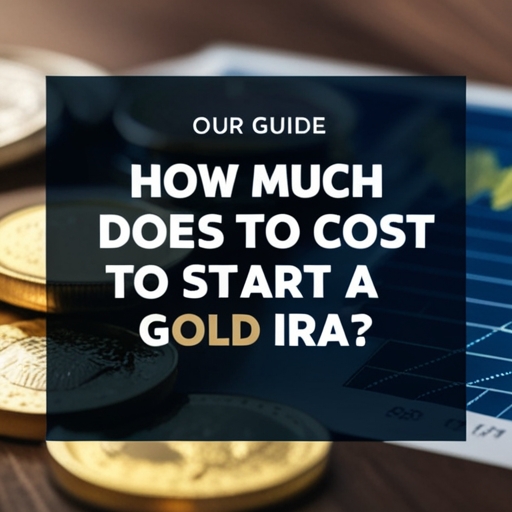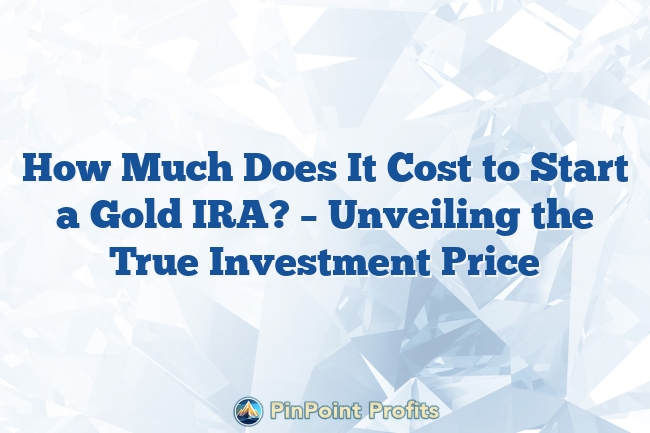Investing in a Gold IRA can be a smart way to diversify your retirement portfolio and protect your wealth against economic uncertainties. This comprehensive guide will explore the initial investment requirements, costs, benefits, and considerations for starting a Gold IRA journey.
| Key Points | Description |
|---|---|
| Initial Investment | Typically ranges from $5,000 to $25,000 |
| Factors Influencing Cost | Gold type, custodian fees, funding method, storage options |
| Benefits | Portfolio diversification, inflation hedge, tax advantages |
| Risks | Price volatility, hidden costs, liquidity concerns |
| Long-term Potential | Historical value preservation, performance during economic uncertainty |
What is the initial investment for a Gold IRA?
The initial investment for a Gold IRA varies depending on several factors. Typically, the minimum investment ranges from $5,000 to $25,000.
This amount is used to purchase IRS-approved gold, such as gold bullion or gold coins. When setting up a Gold IRA, you need to consider the cost of the gold itself and the current gold spot price.
Additionally, there are setup fees charged by the IRA custodian. These fees cover the administrative costs of opening and maintaining the account.

A Gold IRA is a type of self-directed IRA, allowing you to invest in physical gold. This offers a hedge against inflation and provides a safe-haven asset for your retirement portfolio.
However, it's crucial to understand the IRA contribution limits and IRS regulations. These factors influence how much you can invest initially.
Factors influencing the cost of a Gold IRA
Several factors influence the cost of a Gold IRA. Understanding these can help you make informed decisions:
1. Type of gold: Gold bars, gold coins, and gold bullion all have different costs.
2. Gold spot price: The current market price of gold plays a significant role in determining the cost.
3. IRA custodian fees: These fees vary between providers and can include setup fees, annual maintenance fees, and storage fees.
4. Funding method: You can fund your Gold IRA through an IRA rollover, 401(k) rollover, or direct contributions. Each method has its own costs and tax implications.
5. Choice of precious metals depository: Some depositories charge higher storage fees than others.
Market conditions and economic factors can also influence the cost of a Gold IRA. Gold is considered a safe-haven asset, and its price can rise during economic uncertainty.
How to minimize fees when starting a Gold IRA
Minimizing fees when starting a Gold IRA is crucial for maximizing your investment. One way to reduce fees is by choosing a custodian with competitive rates.
Another strategy is to select a cost-effective precious metals depository. Some depositories offer lower storage fees, which can significantly reduce your overall costs.
Consider funding your Gold IRA through an IRA transfer or IRA rollover. These methods can help you avoid taxes and penalties, reducing your costs.
Opt for gold coins or gold bars with lower premiums. The premium is the additional cost above the gold spot price.
Lastly, stay informed about market conditions and gold investment strategies. This knowledge can help you make timely decisions and avoid unnecessary costs.
Comparing Gold IRA providers
Comparing Gold IRA providers is essential for finding the best option for your investment. Start by evaluating the custodian's fees, looking for providers with competitive setup, annual maintenance, and storage fees.
Next, assess the range of IRS-approved gold options offered by each provider. Some providers offer a wider selection of gold coins, gold bars, and gold bullion.
Consider the provider's reputation and customer service. Read reviews and testimonials to gauge their reliability and support.
Check if the provider offers educational resources and guidance. This can help you understand the tax implications and benefits of a Gold IRA.
Lastly, evaluate the provider's storage options. Ensure they offer secure and affordable physical gold storage at a reputable precious metals depository.
Hidden costs in Gold IRA investments
Hidden costs in Gold IRA investments can impact your returns. Being aware of these costs is crucial for managing your investment:
- Premium on gold coins and gold bars
- Bid-ask spread
- Storage fees
- Transaction fees
- Additional account maintenance fees
The premium is the additional cost above the gold spot price. The bid-ask spread is the difference between the buying and selling price of gold.
Storage fees can vary depending on the custodian and depository. Transaction fees are charged when buying or selling gold within your IRA.
Some providers charge additional fees for account maintenance or administrative services. These fees can add up over time, affecting your overall returns.
Understanding storage fees for precious metals
Understanding storage fees for precious metals is essential for managing your Gold IRA. Storage fees are charged by the custodian for securely storing your gold in a precious metals depository.
There are two main types of storage: segregated and non-segregated. Segregated storage involves storing your gold separately from other investors' assets.
Some custodians charge storage fees as a percentage of the total value of your gold. Others charge a flat fee based on the amount of gold stored.
Additionally, consider the security and reputation of the depository. Ensure it is IRS-approved and offers robust security measures to protect your investment.
Tax implications of a Gold IRA
The tax implications of a Gold IRA are an important consideration for investors. A Gold IRA is a tax-deferred investment, meaning you don't pay taxes on gains until you withdraw funds.
When you withdraw funds from a Gold IRA, the amount is taxed as ordinary income. It's essential to understand the tax rates and plan your withdrawals accordingly.
If you choose a Roth IRA, your contributions are made with after-tax dollars. This means you won't pay taxes on withdrawals, providing a tax-free income in retirement.
IRA rollovers and transfers can have tax implications if not done correctly. It's crucial to follow IRS regulations to avoid taxes and penalties.
Lastly, consider the impact of capital gains tax when selling gold within your IRA. Understanding these tax implications can help you make informed decisions and maximize your investment.
Selecting the right custodian for your Gold IRA
Choosing the right custodian for your Gold IRA is crucial for managing your investment. Start by evaluating the custodian's fees, reputation, and customer service.
Consider the range of IRS-approved gold options offered by the custodian. A wider selection can help you diversify your retirement portfolio.
Check if the custodian offers educational resources and guidance. This can help you understand the tax implications and benefits of a Gold IRA.
Lastly, evaluate the custodian's storage options. Ensure they offer secure and affordable physical gold storage at a reputable precious metals depository.

Advantages of investing in a Gold IRA
Investing in a Gold IRA offers several benefits:
1. Portfolio diversification
2. Hedge against inflation
3. Tax advantages
4. Tangible asset ownership
5. Asset preservation
Gold is a safe-haven asset that can protect your retirement portfolio during economic uncertainty. It provides a hedge against inflation, preserving your purchasing power.
Gold IRAs offer tax advantages as tax-deferred investments, allowing you to grow your portfolio without paying taxes on gains until withdrawal.
Investing in a Gold IRA allows you to hold physical gold, such as gold coins, gold bars, and gold bullion. This tangible asset can provide a sense of security and stability.
Potential risks associated with Gold IRAs
While Gold IRAs offer several benefits, they also come with risks:
– Price volatility
– Hidden costs
– Liquidity concerns
– Regulatory risks
– Custodian selection
Gold prices can fluctuate, affecting the value of your investment. Hidden costs, such as premiums and storage fees, can impact your returns.
Liquidity is another concern, as selling physical gold can be more challenging than selling other assets. Regulatory risks are also a factor, as IRS regulations governing Gold IRAs can change.
Lastly, there's the risk of choosing the wrong custodian or depository. A reputable custodian and secure depository are essential for protecting your investment.
Long-term growth potential of a Gold IRA
The long-term growth potential of a Gold IRA is an attractive feature for investors. Gold has historically maintained its value over time, making it a reliable store of wealth.
Gold's performance during economic uncertainty is another factor. As a safe-haven asset, gold tends to rise in value during market downturns.
A Gold IRA's tax-deferred status can also contribute to long-term growth. By deferring taxes on gains, you can reinvest more of your returns, compounding your investment over time.
Additionally, gold's role as a hedge against inflation can protect your purchasing power. This can enhance your portfolio's growth potential by preserving its value in real terms.
Conclusion: Is a Gold IRA worth the investment?
In conclusion, a Gold IRA can be a valuable addition to your retirement portfolio. It offers several benefits, including portfolio diversification, inflation protection, and tax advantages.
However, it's essential to be aware of the risks associated with Gold IRAs. Price volatility, hidden costs, and liquidity concerns can impact your returns.
Choosing the right custodian and depository is vital for protecting your investment. By carefully evaluating your options and staying informed, you can make the most of your Gold IRA.
Ultimately, whether a Gold IRA is worth the investment depends on your individual goals and risk tolerance. If you're seeking a reliable store of value and a hedge against economic uncertainty, a Gold IRA may be a worthwhile consideration.
Frequently Asked Questions
What is the difference between a Gold IRA and a traditional IRA?
A Gold IRA allows investment in physical gold and other precious metals, while a traditional IRA typically involves stocks, bonds, and mutual funds. The main difference lies in asset types and diversification benefits.
Can I hold other precious metals in a Gold IRA?
Yes, a Gold IRA can hold other IRS-approved precious metals like silver, platinum, and palladium, allowing further diversification. Ensure the metals meet IRS purity standards.
How do I fund a Gold IRA?
You can fund a Gold IRA through an IRA rollover, 401(k) rollover, or direct contributions. Each method has its own tax implications and requirements. Choose the option that best suits your financial situation.

